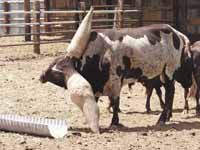| CT Woodie the Watusi has a pair of horns which are among the world’s largest. |
Duane and Kolene Gilbert have been raising Watusi cattle for 22 years. Duane said they just wanted something different and different is what they got. CT Woodie is a 4-year-old Watusi with a good bloodline and some big horns. Woodie has bulbous horns which expand out from his head.
Duane said, “He is a breeding bull we bought when he was a yearling. We had no idea his horns would get this big. We recently returned from the World Watusi Show in Pueblo, Colo. where he was a grand champion.
“We have traveled to shows in Kansas, California and Oregon. Over the years, we have produced a number of grand champions, futurity champions and premier exhibitor prizes, winning numerous trophies and ribbons.
“Through the process of showing our cattle we have had a number of referrals. We are in the process of shipping semen to South Africa. They have a limited gene pool over there and needed some new bloodlines for their cattle. As far as we know we are the first to ship to South Africa.
“We know that Woodie is one of the largest in the world. Woodie has seven calves this year; two in California; one in Kansas, one in DesMoines, Iowa; two here in Castle Dale and one in Florida. Other producers buy our cows which are pregnant with Woodie’s calves, or he can be bred to their cows. Evidence of Watusi cattle dates back to the Egyptians, where pictures of them are depicted on their walls. Evidence is also present in Africa showing a wide spread population of Watusi. Watusi cattle are very protective of their young. They are instilled with a herding instinct and they always stick together as a matter of protection.
“Calves weigh between 25-35 pounds. The cows are pregnant about nine months. The calves are born with very little hair. We keep about 20 head of cows and with the bulls and calves we have about 40 head. We have had a good time meeting people from all over the United States and have done a lot of traveling. Last month we traveled to a show in Missouri and stopped by Nauvoo and saw the sights there. We have planned our vacations around our trips to sell and show animals. One trip out to California we also did some deep sea fishing. We have met a lot of really nice people.
“I have no idea what Woodie’s horns weigh, but he weighs close to 1,100 pounds. I would guess they weigh close to 150 pounds. While their horns are growing they have a lot of blood in them, which also adds to their weight. For four years their horns will experience normal growth, when the bull is around 5-6 years old, they will grow in circumference and they grow in length up to 10 years. Woodie’s father had medium upswept horns and his mom had medium horns. His grandparents had extremely large horns. Woodie is not unusual, he’s exceptional.
“A lot of other growers have wanted our pregnant cows, just because of his large horns, bloodline and confirmation. Watusi are raised in the United States for show and personal enjoyment. The meat is low cholesterol beef without much fat. Woodie’s horn circumference is now 40 inches plus. We have talked to the owners of a steer in Arkansas that measures 37.5 inches and we have seen pictures of him,” said Duane.
Kolene said, “The Watusi cattle have such a good even temperament and have been fun to raise. Even though Woodie has such big horns he always knows where his horns are. They can move their heads to go through the gates really easily. Woodie likes to eat alone, he is shy about eating with the other bulls and one reason is that he doesn’t want his horns touched. They are sensitive to the touch because they are growing so much. Woodie eats like a normal bull his weight.”
Duane said, “Genetics and good feed produce good quality animals. One of the biggest contributors is the Utah feed. We grow our own hay and buy grain for the animals for use in the winter. Utah has high quality hay which is the envy of other producers we talk to around the country. The dominant color in Watusi has been liver and white, but with selective breeding we have been able to add some color in the animals. You don’t know for sure what a bull is going to produce for a few years, so a lot of it is trial and error. It’s a cross between genetics and bloodlines and you just hope you made the right decisions.”
The young calves are born with a bald spot where the horns will grow.
The cows have longer and thinner horns and the steers horns are bigger and thicker.
Woodie the Watusi seems content to wander around the pastures and corral near Castle Dale, he is unaware that his large horns are anything out of the ordinary.

